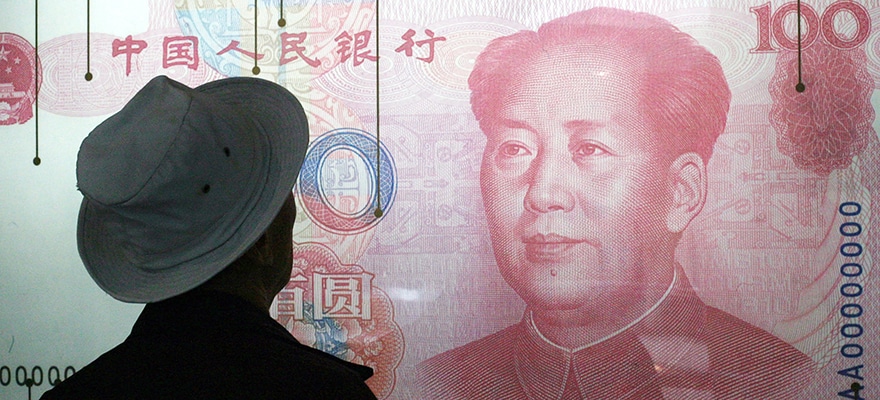China’s foreign-Exchange reserves have taken a tumble, reaching their lowest level in four years as the rallying US dollar impacts on the value of its holdings.
According to a statement issued by the People’s Bank of China, the world’s largest currency hoard fell by $28 billion to $3.19 trillion in May. That's almost in line with the $3.2 trillion median forecast of economists surveyed by Bloomberg.
The new world of online trading, fintech and marketing - register now for the Finance Magnates Tel Aviv Conference, June 29th 2016.
Li Wei, a China and Asia economist at Commonwealth Bank of Australia in Sydney, commented: "Depreciation expectations faded and the central bank didn’t burn its reserves to intervene in the foreign exchange market. The drop was largely due to the valuation effect of a strong dollar, which Leads to the depreciation of other currencies."
Although there has been further weakness against the greenback, the PBOC has not had to deplete its cash to support the yuan as some stability returns to the currency. Reserves have generally been steady this year, halting the steep decline of 2015, however, the May figures extend the decline to 20 percent from a near $4 trillion peak in June 2014.
Stronger US Dollar
Movements in the dollar are likely to continue to play a key role in driving outflow pressures, according to Julian Evans-Pritchard, a China economist at Capital Economics, who has estimated net capital outflows of $32 billion in May, down from the $120 billion per month pace seen late last year and early this year.
Furthermore, a Federal Reserve interest rate rise will likely lead to a stronger dollar, which would prompt capital to flow back to the U.S. and cause weakness in emerging market currencies.
The yuan, incidentally, has posted its biggest two-day drop versus its peers since February, fueling speculation that authorities are weakening the currency to counter a slowdown in the economy. The Chinese currency fell 0.8 percent against a trade-weighted basket this week to the lowest level since October 2014.
First Investment Quota to U.S. to Boost Yuan
In a bid to boost its efforts to broaden use of the yuan overseas and lure capital back to the mainland, China will be giving a 250 billion yuan ($38 billion) investment quota to the U.S.
The Chinese currency quota will be allocated under the Renminbi Qualified Foreign Institutional Investor scheme. This is the first time China has given the quota to the U.S., which allows overseas institutions to use the yuan raised offshore to invest in onshore capital markets and serves to further strengthen financial cooperation between the two nations.
China’s foreign-Exchange reserves have taken a tumble, reaching their lowest level in four years as the rallying US dollar impacts on the value of its holdings.
According to a statement issued by the People’s Bank of China, the world’s largest currency hoard fell by $28 billion to $3.19 trillion in May. That's almost in line with the $3.2 trillion median forecast of economists surveyed by Bloomberg.
The new world of online trading, fintech and marketing - register now for the Finance Magnates Tel Aviv Conference, June 29th 2016.
Li Wei, a China and Asia economist at Commonwealth Bank of Australia in Sydney, commented: "Depreciation expectations faded and the central bank didn’t burn its reserves to intervene in the foreign exchange market. The drop was largely due to the valuation effect of a strong dollar, which Leads to the depreciation of other currencies."
Although there has been further weakness against the greenback, the PBOC has not had to deplete its cash to support the yuan as some stability returns to the currency. Reserves have generally been steady this year, halting the steep decline of 2015, however, the May figures extend the decline to 20 percent from a near $4 trillion peak in June 2014.
Stronger US Dollar
Movements in the dollar are likely to continue to play a key role in driving outflow pressures, according to Julian Evans-Pritchard, a China economist at Capital Economics, who has estimated net capital outflows of $32 billion in May, down from the $120 billion per month pace seen late last year and early this year.
Furthermore, a Federal Reserve interest rate rise will likely lead to a stronger dollar, which would prompt capital to flow back to the U.S. and cause weakness in emerging market currencies.
The yuan, incidentally, has posted its biggest two-day drop versus its peers since February, fueling speculation that authorities are weakening the currency to counter a slowdown in the economy. The Chinese currency fell 0.8 percent against a trade-weighted basket this week to the lowest level since October 2014.
First Investment Quota to U.S. to Boost Yuan
In a bid to boost its efforts to broaden use of the yuan overseas and lure capital back to the mainland, China will be giving a 250 billion yuan ($38 billion) investment quota to the U.S.
The Chinese currency quota will be allocated under the Renminbi Qualified Foreign Institutional Investor scheme. This is the first time China has given the quota to the U.S., which allows overseas institutions to use the yuan raised offshore to invest in onshore capital markets and serves to further strengthen financial cooperation between the two nations.

















